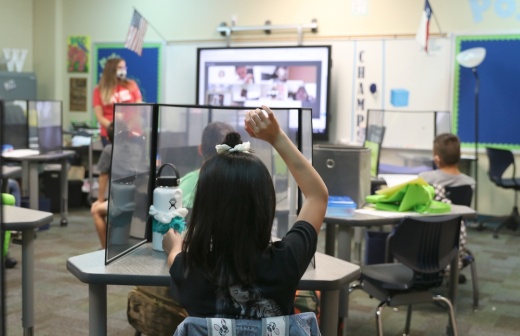Despite faring above average on the end-of-course State of Texas Assessments of Academic Readiness, both GCISD and CISD are planning to focus on bridging the learning gap and addressing mental health concerns as students return for a new school year.
While the learning gap will be covered by federal funds, both districts will also have to make room in their budgets for pay raises and unforeseen pandemic costs in fiscal year 2020-21.
Budget overlook for FY 2021-22
GCISD adopted its FY 2021-22 budget on June 21, with an expected general fund of almost $188 million and expenditures near $195 million. According to the district’s budget book, GCISD is expecting a deficit of $7.5 million. However, GCISD Chief Financial Officer DaiAnn Mooney said that is not always final.
“If you look back historically, the past couple of years we have approved deficit budgets—but then when we actually end the fiscal year, we typically do not incur that deficit,” Mooney said.
CISD will likely also adopt a deficit for its 2021-22 budget. Although a final vote is not due until Aug. 23, the district could incur a deficit around $3 million. Expenditures are projected to be about $121.8 million. CISD Superintendent Lane Ledbetter also announced the board will look into launching a budget cost containment committee during that same meeting to balance the budget.
“This is a common management practice for this district to adopt a deficit budget,” said William Wooten, CISD assistant superintendent for financial services. “[We] normally come out of it, but because of [COVID-19], we were not able to capture the non-major revenues [like school lunch fees we usually have].”
Funding for school districts primarily comes from local sources, such as property taxes; transportation fees and investments; state sources; and, occasionally, federal sources as a result of programs and initiatives. However, not all funding sources are constant for local districts.
“Major revenue is money you know you’re going to get. Non-major revenue is money that you hope you get, but you can’t control that. You can only control your major revenues—which is the state and local property taxes,” Wooten said.
Both districts said they plan on using a portion of their allotted funds from the third round of Elementary and Secondary School Emergency Relief funding to balance out some outstanding debt from the 2020-21 school year.
Distributing ESSER III funding
Federal funding to address learning loss and unforeseen pandemic-related costs is expected to offset the COVID-19 fallout. According to the Texas Education Agency, funds must provide supports that are not academic in nature in light of the challenges of COVID-19, and needed assistance to enable homeless children and youth to attend school and participate fully in school activities.
GCISD has been allocated over $9.1 million, and CISD has been allocated just over $1 million. Districts have three years to spend the federal money. A minimum of 20% of allotted funds must be set aside to mitigate learning loss, according to TEA documents.
In GCISD, about $4.3 million will be set aside for learning loss mitigation. Some of the district’s plans for this include hiring additional staff, adding classes and instruction outside of regular school hours and providing busing for students who might otherwise not be able to take advantage of learning opportunities.
“One of the things that TEA encouraged us to remember as well is that this coming fall, things may evolve with the pandemic or as we learn more about the extent of the learning loss amongst students,” said Shannon Tovar, director of accountability and continuous improvement at GCISD. “We do have the opportunity to revisit the application every six months.”
The rest of the funding will offset any debts incurred this past fiscal year related to COVID-19, said Mooney.
“Because we had been so conservative in our budgeting, with [House Bill] 3 revenues [a school finance bill passed by the Texas Legislature in 2019], we were able to take that hit to our revenue in 2019-20, and ... roll over the [Coronavirus Aid, Relief and Economic Security] Act money into 2021, [which we used] for our PPE and our contact-tracing costs,” she said.
CISD will be using its funds similarly. Courtney Carpenter, assistant superintendent at CISD, said between 50%-60% of the district’s ESSER III funds will address learning loss and mental health concerns.
“Our No. 1 priority is students’ learning, and no matter what a STAAR score says, we know that there’s high expectations in the district,” she said.
According to Carpenter, the district’s academic recovery plan includes expanded summer programming the following year to serve more students, high-impact tutoring, and after-school tutoring.
Rewarding “hero work”
Pay raises for employees are among the largest new expenses for the upcoming fiscal years. For the last several months, the unprecedented workplace environment has led many teachers across the state to seek out districts with better resources and pay—or even to retire early, said Steven Poole, executive director of the United Educators Association, an independent association representing more than 26,000 North Texas public school employees.
Poole said raise amounts approved across the region so far have been larger than in the past.
“A lot of teachers were teaching both in-person and virtually at the same time and doing hero work,” Poole said. “A lot of these school boards are increasing salaries to reward employees for their hard work.”
GCISD has approved raises. GCISD teachers, nurses and librarians will receive a raise of at least $1,250. Other staff will receive a pay increase equivalent to 2% of the midpoint between the highest and lowest wages offered for their position.
•“We know we’re a little bit behind the market, but we don’t have a shortage of teacher applications,” Mooney said. “We don’t have a great exodus of teachers going to other districts because of the increase in pay. We do have a lot of teachers this year leaving the profession, but I don’t necessarily attribute that to pay.”
On Aug. 2, CISD unanimously approved a 2% pay increase for all positions in the district. The decision came after discussion of whether to give teaching staff a larger raise than support staff, with some trustees voicing concern over the budget’s deficit.
“I know every dollar counts, but we need to value our staff—they are the reason this district is excellent,” CISD Board of Trustees President Michelle Moore said.
Poole said local districts have had to compete for employees not only among themselves but also against private employers.
“They also need to focus on the working conditions,” he said. “That’s one of the most important reasons why someone may stay at a school district or choose to go look elsewhere.”









